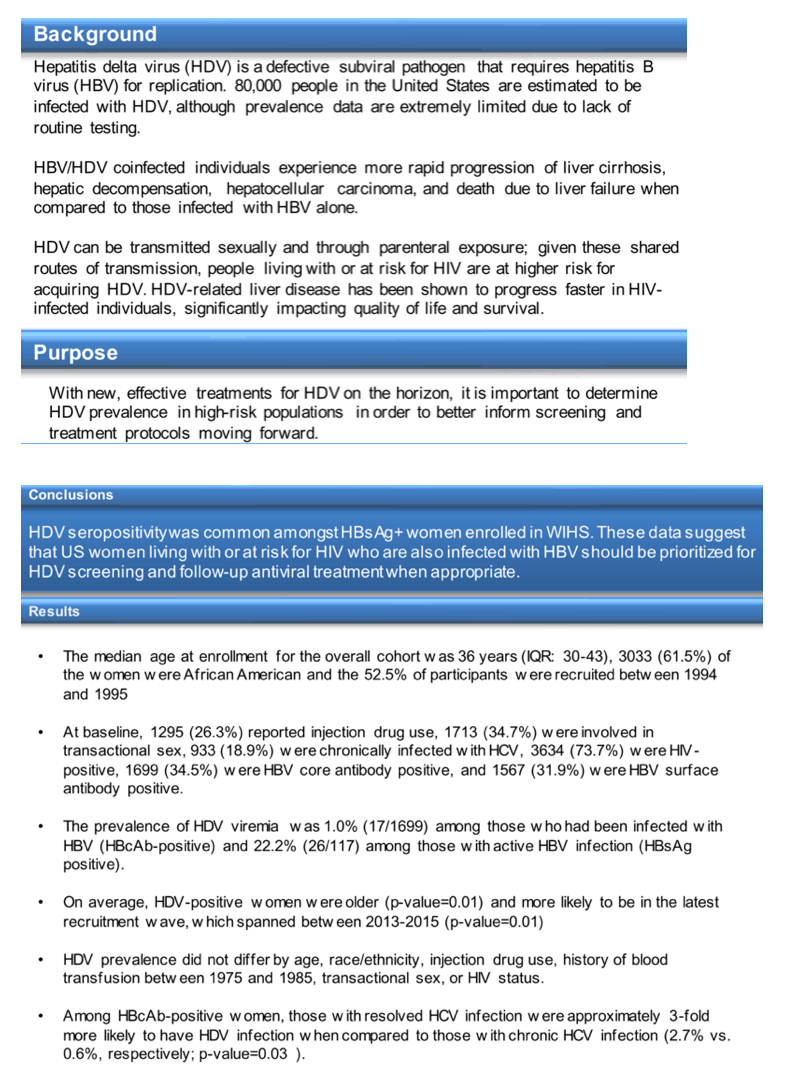 |
 |
 |
| |
HDV seropositivity was common amongst HBsAg+ women enrolled in
WIHS. 26 (22%) of the 117 HBsAg+ women were HDV seropositive
|
| |
| |

Background: People living with or at risk for HIV may become infected with hepatitis B virus (HBV) and hepatitis D virus (HDV) due to shared routes of transmission. With new HDV treatments on the horizon, a better understanding of HDV prevalence and epidemiology in high-risk populations may aid in identifying and treating HDV-infected individuals.
Methods: The Women's Interagency HIV Study (WIHS) is a prospective cohort study initiated in 1994 to investigate the natural history and treatment of HIV in US women. WIHS participants (n=4932) recruited in 4 waves across 10 sites between 1994-2015 were tested for HBV surface antigen (HBsAg) at their enrollment (baseline) study visit. We tested the baseline plasma samples from 117 HBsAg+ women for presence of HDV antibodies using the quantitative microarray antibody capture (Q-MAC) assay. Baseline characteristics reflective of demographic and risk-behaviors for HDV-positive and -negative participants were compared using χ2 and t-test. The prevalence of HDV infection was calculated separately within the whole cohort, anti-HBc positive participants, and HBsAg-positive participants. Women who tested negative for HBsAg were considered negative for HDV.
Results: The median age of the 117 HBsAg+ women was 35 years (IQR: 30-40), 74% of these women were African American, and 56% were recruited between 1994-1995. At baseline, 36 (31%) reported injection drug use, 56 (48%) reported transactional sex, 18 (15%) were hepatitis C virus (HCV) RNA positive, and 102 (87%) were HIV seropositive. 26 (22%) of the 117 HBsAg+ women were HDV seropositive. When compared to those who were HDV seronegative, HDV seropositive women were older (p-value=0.01) and more likely to have entered the WIHS cohort between 2013-2015 (p-value=0.01). Among anti-HBc positive participants, anti-HDV prevalence was lower in those with chronic HCV infection (0.6%) than in those who were never infected with HCV (2.0%; p-value=0.02) or those with resolved HCV infection (2.7%; p-value=0.03) .
Conclusion: HDV seropositivity was common amongst HBsAg+ women enrolled in WIHS. These data suggest that US women living with or at risk for HIV who are also infected with HBV should be prioritized for HDV screening and follow-up antiviral treatment when appropriate.

|
| |
|
 |
 |
|
|